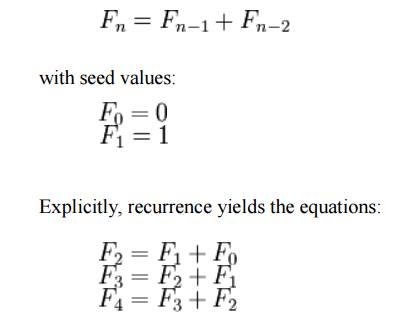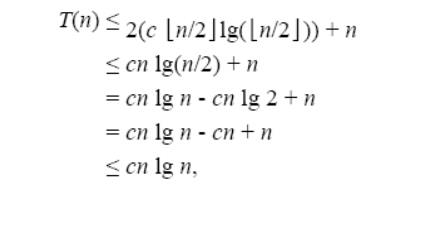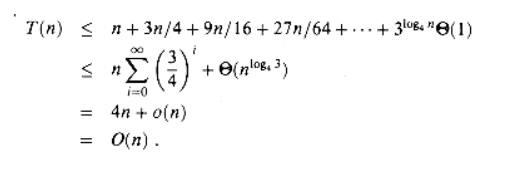Chapter: Analysis and Design of Algorithm
Analysis of Algorithm: Fibonacci numbers
Fibonacci numbers
The
Fibonacci numbers are defined using the linear recurrence relation

We obtain
the sequence of Fibonacci numbers which begins:
0, 1, 1,
2, 3, 5, 8, 13, 21, 34, 55, 89, ...
It can be
solved by methods described below yielding the closed form
expression which involve powers of the two roots of the
characteristic polynomial t2
= t + 1; the generating function of the sequence is the rational function t
/ (1 ŌłÆ t ŌłÆ t2).
Solving
Recurrence Equation i. substitution
method
The substitution method for solving
recurrences entails two steps:
1. Guess the form of the solution.
2. Use mathematical induction to find
the constants and show that the solution works. The name comes from the
substitution of the guessed answer for the function when the inductive
hypothesis is applied to smaller values. This method is powerful, but it
obviously
can be applied only in cases when
it is easy to guess the form of the answer. The substitution method can be used
to establish either upper or lower bounds on a recurrence. As an example, let
us determine an upper bound on the recurrence

which is similar to recurrences (4.2) and (4.3). We guess that the solution is T (n) = O(n lg n).Our method is to prove that T (n) Ōēż cn lg n for an appropriate choice of the constant c > 0. We start by assuming that this bound holds for ŌīŖn/2Ōīŗ, that is, that T (ŌīŖn/2Ōīŗ) Ōēż c ŌīŖn/2Ōīŗ lg(ŌīŖn/2Ōīŗ).
Substituting into the recurrence yields

where the
last step holds as long as c Ōēź 1.
Mathematical
induction now requires us to show that our solution holds for the boundary
conditions. Typically, we do so by showing that the boundary conditions are
suitable as base cases for the inductive proof. For the recurrence (4.4), we
must show that we can choose the constant c large enough so that the bound T(n)
= cn lg n works for the boundary conditions as well. This requirement can
sometimes lead to problems. Let us assume, for the sake of argument, that T (1)
= 1 is the sole boundary condition of the recurrence. Then for n = 1, the bound
T (n) = cn lg n yields T (1) = c1 lg 1 = 0, which is at odds with T (1) = 1.
Consequently, the base case of our inductive proof fails to hold.
This
difficulty in proving an inductive hypothesis for a specific boundary condition
can be easily overcome. For example, in the recurrence (4.4), we take advantage
of asymptotic notation only requiring us to prove T (n) = cn lg n for n Ōēź n0,
where n0 is a constant of our choosing. The idea is to remove the difficult
boundary condition T (1) = 1 from consideration
1. In the inductive proof.
Observe
that for n > 3, the recurrence does not depend directly on T
(1).
Thus, we can replace T (1) by T (2) and T (3) as the base cases in the
inductive proof, letting n0 = 2. Note that we make a distinction between the
base case of the recurrence (n = 1) and the base cases of the inductive proof
(n = 2 and n = 3). We derive from the recurrence that T (2) = 4 and T (3) = 5.
The inductive proof that T (n) Ōēż cn lg n for some constant c Ōēź 1 can now be
completed by choosing c large enough so that T (2) Ōēż c2 lg 2 and T (3) Ōēż c3 lg
3. As it turns out, any choice of c Ōēź 2 suffices for the base cases of n = 2
and n = 3 to hold. For most of the recurrences we shall examine, it is
straightforward to extend boundary conditions to make the inductive assumption
work for small n.
2. The iteration method
The
method of iterating a recurrence doesn't require us to guess the answer, but it
may require more algebra than the substitution method. The idea is to expand
(iterate) the recurrence and express it as a summation of terms dependent only
on n and the initial conditions. Techniques for evaluating summations can then
be used to provide bounds on the solution.
As an
example, consider the recurrence
T(n) =
3T(n/4) + n.
We
iterate it as follows:
T(n) = n
+ 3T(n/4)
= n + 3
(n/4 + 3T(n/16))
= n + 3(n/4
+ 3(n/16 + 3T(n/64)))
= n + 3 n/4
+ 9 n/16 + 27T(n/64),
where
n/4/4 = n/16 and n/16/4 = n/64 follow from the identity (2.4).
How far
must we iterate the recurrence before we reach a boundary condition? The ith term in the series is 3i ![]() n/4i
n/4i![]() . The iteration hits n = 1 when n/4i = 1 or, equivalently, when i exceeds log4 n. By continuing the iteration until
this point and using the bound n/4i
. The iteration hits n = 1 when n/4i = 1 or, equivalently, when i exceeds log4 n. By continuing the iteration until
this point and using the bound n/4i![]()
![]() n/4i, we discover
that the summation contains a decreasing geometric series:
n/4i, we discover
that the summation contains a decreasing geometric series:

3. The master method
The master method provides a
"cookbook" method for solving recurrences of the form

where a Ōēź 1 and b > 1 are constants and f (n) is an asymptotically positive function.
The master method requires
memorization of three cases, but then the solution of many recurrences can be
determined quite easily, often without pencil and paper.
The recurrence (4.5) describes the running time of an algorithm
that divides a problem of size
n into a subproblems, each of size n/b, where a and b are positive constants. The a subproblems are solved recursively, each in time T (n/b). The cost of dividing the problem and combining the results of the subproblems is described by the function f (n). (That is, using the notation from Section 2.3.2, f(n) = D(n)+C(n).) For example, the recurrence arising from the MERGE-SORT procedure has a = 2, b = 2, and f (n) = ╬ś (n).
As a matter of technical
correctness, the recurrence isn't actually well defined because
n/b might not be an integer. Replacing each of the
a terms T (n/b) with either T (ŌīŖn/bŌīŗ) or T (Ōīłn/bŌīē) doesn't affect the asymptotic behavior of the
recurrence, however. We normally
find it convenient, therefore, to omit the floor and ceiling functions when
writing divide-and- conquer recurrences of this form.
Related Topics